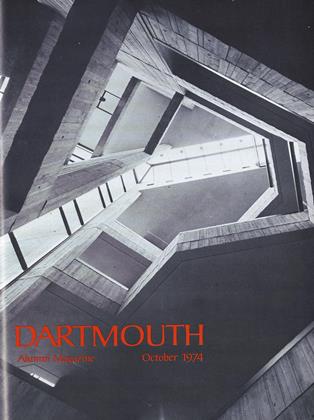By C. A. Schicke '47. Boston.Little, Brown and Company, 1974. 246 pp.Illustrated with photographs. $6.95.
Wine, women, and song always have been popular extra-curricular pursuits. For the last of these, in Hanover in the '20s, you went to either Allen's Drug Store or Campion's Smoke Shop for the new dance records by Paul Whiteman, Duke Ellington, Ted Lewis or Louis Armstrong. The world of music was ours on a 10" shellac disc for 75¢.
It all started when young Thomas Edison demonstrated "his baby" to the editors of Scientific American. That's what he called his handcranked, tinfoil-wrapped cylindrical contraption. "As he turned the handle," a staff member reported, "the machine inquired as to our health, asked us how we liked the phonograph, informed us that it was very well, and bid us a cordial goodnight."
Edison rated the reproduction of music only fourth in a list of ten uses for his invention. But music was the product that sold - ready-to music was the product sold - ready hear music.Carso gave the industry a hugè boost, starting in 1904. 1913 there was a growing library of fine classical recorded music. The first "original cast" souvenir records of musical revues were pressed in 1915. The first "jass" records in 1917. Electrical recording in 1925 brought new depth, brightness, and realism to the sound. Al Jolson with "Sonny Boy" in 1927, first of the talking picture songs. Juke boxes in 1933. Bing, and Swing, and all those great records of the Big Band era. Then no records but reissues when Petrillo banned "canned music" in 1942. But soon a flood of fine pop singers like Sinatra, Como, and Shore.
By 1947 the industry was recording on magnetic tape. Then came long-plays and "hi fi." The big news in 1959 was a scandal over "payola" to the disc jockeys in the radio stations. And always more new stars Presley, Boone, Darin, Anka, Nat "King" Cole, Chubby Checker, and the Beatles. Stereo arrived in the 19605. Plus tape decks and cassettes for in-car entertainment. The newest wrinkle is four-channel home playback systems.
Part Two of Schicke's fascinating biography tells in useful detail just how a record company operates, and how to succeed in this big and varied industry. Particular attention is paid to the highly-paid Artists and Repertoire (A&R) man who produces those records that will sell a million copies in a few short weeks.
Mr. Holbrook's avocation is jazz history andjazz musicians; his business, advertising,marketing, concepts copy, and research withheadquarters in Phoenix, Arizona.
 View Full Issue
View Full Issue
More From This Issue
-
 Feature
Feature"THE KINGDOM OF GOD HAS COME"
October 1974 By MARy BISHOP ROSS -
 Feature
FeatureMore than a beast, Less than an angel
October 1974 By PETER A. BIEN -
 Feature
FeatureMountain of Storms
October 1974 By ANDREW HARVARD, TODD THOMPSON -
 Feature
FeatureBelieve It or Not!
October 1974 By GREGORY C. SCHWARZ -
 Article
ArticleBig Green Teams
October 1974 By JACK DEGANGE -
 Class Notes
Class Notes1923
October 1974 By WALTER C. DODGE, DR. THEODORE MINER
Books
-
 Books
BooksShelflife
July/August 2005 -
 Books
BooksGID GRANGER,
April 1946 By Herbert F. West Jr. (Aged 11) -
 Books
BooksBriefly Noted
FEBRUARY 1969 By J.H. -
 Books
BooksSHOW ME THE WAY TO GO HOME.
January 1960 By JOHN R. SCOTFORD JR. '38 -
 Books
BooksAN INTRODUCTION TO MONEY AND BANKING
OCTOBER 1972 By MICHAEL R. DARBY '67 -
 Books
BooksTHE ROMAN CATHOLIC PROBLEM.
October 1954 By WILLIAM KELLEY WRIGHT

